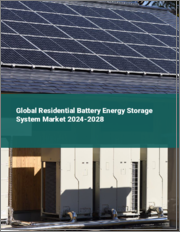
|
시장보고서
상품코드
1635991
주택용 ESS(에너지 저장 시스템) 시장 : 기술 유형별, 정격 출력별, 소유 유형별, 연결 유형별, 지역별(2025-2033년)Residential Energy Storage System Market by Technology Type, Power Rating, Ownership Type, Connectivity Type, and Region 2025-2033 |
||||||
주택용 ESS(에너지 저장 시스템) 시장의 세계 시장 규모는 2024년에 12억 3,100만 달러에 달했으며, IMARC Group은 2025년부터 2033년까지 연평균 18.6%의 연평균 성장률(CAGR)을 기록하여 2033년에는 57억 1,500만 달러에 달할 것으로 예측하고 있습니다. 여러 전력망 자산의 노후화, 에너지 소비 증가, 여러 가정 활동을 수행하기 위한 중단 없는 안정적인 전력에 대한 수요 증가가 시장을 주도하는 주요 요인 중 일부입니다.
주택용 ESS는 전기적, 기계적, 화학적, 열적 에너지의 잉여량을 저장했다가 나중에 필요할 때 소비할 수 있도록 특별히 설계된 첨단 장치를 말합니다. 태양광발전(PV) 시스템에서 생산된 태양광발전과 결합할 수 있으며, 배터리는 낮 동안 생성된 에너지의 추가 축적을 촉진합니다. 주택용 ESS는 전력 보안 향상, 에너지 낭비 감소, 신뢰성 및 복원력 향상, 환경 영향 최소화, 비상시 백업, 전기 요금 절감으로 인한 경제적 절감을 실현합니다. 이 외에도 주택용 ESS는 안전하고, 유연하며, 설치가 용이하고, 계통 시스템에 대한 의존도를 낮추고, 태양광 자급자족을 극대화할 수 있습니다. 그 결과, 주택용 ESS는 전력 공급을 중단하지 않기 위해 주택 부문에 널리 설치되고 있습니다.
주택용 ESS 시장 동향:
에너지 소비의 대폭적인 증가는 시장 성장을 촉진하는 중요한 요인 중 하나입니다. 이에 따라 여러 가정 활동을 수행하기 위한 중단 없는 안정적인 전력에 대한 요구가 증가하고 있으며, 이는 주택용 ESS에 대한 수요를 촉진하고 있습니다. 이러한 장치는 세제 혜택을 제공하여 다른 인센티브의 개입을 줄이고, 지역 송전망의 피크 부하를 제거하며, 전력 품질을 최적화하기 위해 전력 저장 시스템으로 널리 채택되고 있습니다. 또한, 악천후로 인한 송전망 자산의 노후화, 에너지 공급 시스템의 초크 포인트 및 병목현상, 비용 상승 및 지역 정전 위험의 증가도 시장 성장의 원동력이 되고 있습니다. 환경 의식의 증가와 정부의 녹색 이니셔티브의 시행으로 사용자는 화력 발전소를 ESS로 대체하여 재생에너지 발전을 지원하고 송전망의 신뢰성을 높이려고 노력하고 있습니다. 또한, 리튬이온(Li-ion) 이차전지의 보급은 전력 효율 향상, 저렴한 가격, 다른 기존 배터리보다 긴 충전 유지 시간 등 여러 가지 장점으로 인해 시장 성장을 뒷받침하고 있습니다. 이와는 별도로, 전기자동차(EV)에 ESS의 광범위한 설치와 맞춤형 지능형 가정용 에너지 제어 시스템의 출시는 시장 성장에 긍정적인 영향을 미치고 있습니다.
본 보고서에서 다루는 주요 질문
- 주택용 ESS 시장의 세계 시장 규모는?
- 2025-2033년 세계 주택용 ESS 시장의 예상 성장률은?
- 세계 주택용 ESS 시장을 이끄는 주요 요인은 무엇인가?
- COVID-19가 세계 주택용 ESS 시장에 미치는 영향은?
- 전 세계 주택용 ESS 시장의 기술 유형별 현황은?
- 세계 주택용 ESS 시장의 정격 출력별 비중은?
- 세계 주택용 ESS 시장의 소유권 유형별 현황은?
- 전 세계 주택용 ESS 시장의 연결 유형별 현황은?
- 세계 주택용 ESS 시장의 주요 지역은?
- 세계 주택용 ESS 시장의 주요 플레이어/기업은?
목차
제1장 서문
제2장 조사 범위와 조사 방법
- 조사 목적
- 이해관계자
- 데이터 소스
- 1차 정보
- 2차 정보
- 시장 추정
- 상향식 접근
- 하향식 접근
- 조사 방법
제3장 주요 요약
제4장 소개
- 개요
- 주요 업계 동향
제5장 세계의 주택용 ESS 시장
- 시장 개요
- 시장 실적
- COVID-19의 영향
- 시장 예측
제6장 시장 내역 : 기술 유형별
- 리튬이온 배터리
- 시장 동향
- 시장 예측
- 납축배터리
- 시장 동향
- 시장 예측
- 기타
- 시장 동향
- 시장 예측
제7장 시장 내역 : 정격 출력별
- 3-6Kw
- 시장 동향
- 시장 예측
- 6-10Kw
- 시장 동향
- 시장 예측
- 10Kw 이상
- 시장 동향
- 시장 예측
제8장 시장 내역 : 소유 유형별
- 고객 소유
- 시장 동향
- 시장 예측
- 유틸리티 소유
- 시장 동향
- 시장 예측
- 서드파티 소유
- 시장 동향
- 시장 예측
제9장 시장 내역 : 연결 유형별
- 온그리드
- 시장 동향
- 시장 예측
- 오프그리드
- 시장 동향
- 시장 예측
제10장 시장 내역 : 지역별
- 북미
- 미국
- 캐나다
- 아시아태평양
- 중국
- 일본
- 인도
- 한국
- 호주
- 인도네시아
- 기타
- 유럽
- 독일
- 프랑스
- 영국
- 이탈리아
- 스페인
- 러시아
- 기타
- 라틴아메리카
- 브라질
- 멕시코
- 기타
- 중동 및 아프리카
제11장 촉진요인, 억제요인, 기회
- 개요
- 성장 촉진요인
- 성장 억제요인
- 기회
제12장 밸류체인 분석
제13장 Porter's Five Forces 분석
- 개요
- 구매자의 교섭력
- 공급 기업의 교섭력
- 경쟁 정도
- 신규 참여업체의 위협
- 대체품의 위협
제14장 가격 분석
제15장 경쟁 구도
- 시장 구조
- 주요 기업
- 주요 기업 개요
- ABB Ltd.
- BYD Company Limited
- Delta Electronics Inc.
- Eaton Corporation plc
- Eguana Technologies Inc
- Enphase Energy Inc
- Huawei Technologies Co. Ltd.
- LG Energy Solution Ltd
- Panasonic Corporation
- Samsung SDI Co. Ltd
- Schneider Electric SE
- SENEC(EnBW Energie Baden-Wurttemberg AG)
- Sonnen GmbH
- Tesla Inc.
- Varta AG
The global residential energy storage system market size reached USD 1,231 Million in 2024. Looking forward, IMARC Group expects the market to reach USD 5,715 Million by 2033, exhibiting a growth rate (CAGR) of 18.6% during 2025-2033. The aging of several grid assets, the increasing energy consumption and the growing need for uninterrupted and stable power to perform multiple household activities represent some of the key factors driving the market.
A residential energy storage system (ESS) refers to advanced devices specially designed to store and supply surplus amounts of electrical, mechanical, chemical, and thermal energy for later consumption as per the requirement. It can be combined with solar power that is produced from photovoltaic (PV) systems, and the battery facilitates the further accumulation of energy generated during the day. Residential ESS offers increased power security, greater reduction in energy waste, improved reliability and resilience, minimized environmental impact, emergency backup, and better financial savings by decreasing the electric bill price. Apart from this, residential ESS is safe, flexible, easy to install, reduces the dependence on the grid system, and provides maximized self-supply of solar. As a result, residential ESS is extensively installed in the residential sector to have an uninterrupted power supply.
Residential Energy Storage System Market Trends:
Significantly increasing energy consumption represents one of the key factors driving the market growth. In line with this, the rising need for uninterrupted and stable power to perform multiple household activities have facilitated the demand for residential ESS, which is acting as another growth-inducing factor. Such devices reduce the involvement of additional incentives by offering tax benefits, eliminate peak load on the local grid networks and optimize power quality; thus, they are widely employed as storage systems. Moreover, the increasing aging of several grid assets due to severe weather conditions and the rising deterioration of chokepoints and bottlenecks in the energy delivery systems resulting in higher costs and risk of local power outages are driving the market growth. The fueling environmental consciousness and the enforcement of favorable green initiatives by governments have prompted users to replace thermal power plants with ESS to support renewable energy generation and enhance grid reliability, which is favoring the market growth. Additionally, the widespread adoption of lithium-Ion (Li-ion) rechargeable batteries, owing to their multiple benefits, such as improved power efficiency, affordability, and longer charge retention than other conventional batteries, is supporting the market growth. Apart from this, the extensive installation of ESS in electric vehicles (EVs) and the launch of customizable intelligent home energy control systems are positively impacting the market growth.
Key Market Segmentation:
Technology Type Insights:
- Lithium-ion Batteries
- Lead-acid Batteries
- Others
- The report has also provided a detailed breakup and analysis of the residential energy storage system market based on the technology type. This includes lithium-ion, lead-acid batteries, and others. According to the report, lithium-ion batteries represented the largest segment.
Power Rating Insights:
- 3-6 Kw
- 6-10 Kw
- More Than 10 Kw
Ownership Type Insights:
- Customer-owned
- Utility-owned
- Third-Party Owned
- The report has also provided a detailed breakup and analysis of the residential energy storage system market based on the ownership type. This includes customer, utility, and third-party owned. According to the report, customer-owned represented the largest segment.
Connectivity Type Insights:
- On-Grid
- Off-Grid
Regional Insights:
- North America
- United States
- Canada
- Asia Pacific
- China
- Japan
- India
- South Korea
- Australia
- Indonesia
- Others
- Europe
- Germany
- France
- United Kingdom
- Italy
- Spain
- Russia
- Others
- Latin America
- Brazil
- Mexico
- Others
- Middle East and Africa
- The report has also provided a comprehensive analysis of all the major regional markets that include North America (the United States and Canada); Asia Pacific (China, Japan, India, South Korea, Australia, Indonesia, and others); Europe (Germany, France, the United Kingdom, Italy, Spain, Russia, and others); Latin America (Brazil, Mexico, and others); and the Middle East and Africa. According to the report, Europe was the largest market for residential energy storage systems. Some of the factors driving the Europe residential energy storage system market included the increasing need for uninterrupted supply of power, significant technological advancements, and steadily rising power consumption across the residential sector.
Competitive Landscape:
- The report has also provided a comprehensive analysis of the competitive landscape in the global residential energy storage system market. Detailed profiles of all major companies have also been provided. Some of the companies covered includes ABB Ltd., BYD Company Limited, Delta Electronics Inc., Eaton Corporation plc, Eguana Technologies Inc, Enphase Energy Inc, Huawei Technologies Co. Ltd., LG Energy Solution Ltd, Panasonic Corporation, Samsung SDI Co. Ltd, Schneider Electric SE, SENEC (EnBW Energie Baden-Wurttemberg AG), Sonnen GmbH, Tesla Inc., Varta AG, etc. Kindly note that this only represents a partial list of companies, and the complete list has been provided in the report.
Key Questions Answered in This Report
- 1. How big is the global residential energy storage system market?
- 2. What is the expected growth rate of the global residential energy storage system market during 2025-2033?
- 3. What are the key factors driving the global residential energy storage system market?
- 4. What has been the impact of COVID-19 on the global residential energy storage system market?
- 5. What is the breakup of the global residential energy storage system market based on the technology type?
- 6. What is the breakup of the global residential energy storage system market based on the power rating?
- 7. What is the breakup of the global residential energy storage system market based on the ownership type?
- 8. What is the breakup of the global residential energy storage system market based on the connectivity type?
- 9. What are the key regions in the global residential energy storage system market?
- 10. Who are the key players/companies in the global residential energy storage system market?
Table of Contents
1 Preface
2 Scope and Methodology
- 2.1 Objectives of the Study
- 2.2 Stakeholders
- 2.3 Data Sources
- 2.3.1 Primary Sources
- 2.3.2 Secondary Sources
- 2.4 Market Estimation
- 2.4.1 Bottom-Up Approach
- 2.4.2 Top-Down Approach
- 2.5 Forecasting Methodology
3 Executive Summary
4 Introduction
- 4.1 Overview
- 4.2 Key Industry Trends
5 Global Residential Energy Storage System Market
- 5.1 Market Overview
- 5.2 Market Performance
- 5.3 Impact of COVID-19
- 5.4 Market Forecast
6 Market Breakup by Technology Type
- 6.1 Lithium-ion Batteries
- 6.1.1 Market Trends
- 6.1.2 Market Forecast
- 6.2 Lead-acid Batteries
- 6.2.1 Market Trends
- 6.2.2 Market Forecast
- 6.3 Others
- 6.3.1 Market Trends
- 6.3.2 Market Forecast
7 Market Breakup by Power Rating
- 7.1 3-6 Kw
- 7.1.1 Market Trends
- 7.1.2 Market Forecast
- 7.2 6-10 Kw
- 7.2.1 Market Trends
- 7.2.2 Market Forecast
- 7.3 More Than 10 Kw
- 7.3.1 Market Trends
- 7.3.2 Market Forecast
8 Market Breakup by Ownership Type
- 8.1 Customer-owned
- 8.1.1 Market Trends
- 8.1.2 Market Forecast
- 8.2 Utility-owned
- 8.2.1 Market Trends
- 8.2.2 Market Forecast
- 8.3 Third-Party Owned
- 8.3.1 Market Trends
- 8.3.2 Market Forecast
9 Market Breakup by Connectivity Type
- 9.1 On-Grid
- 9.1.1 Market Trends
- 9.1.2 Market Forecast
- 9.2 Off-Grid
- 9.2.1 Market Trends
- 9.2.2 Market Forecast
10 Market Breakup by Region
- 10.1 North America
- 10.1.1 United States
- 10.1.1.1 Market Trends
- 10.1.1.2 Market Forecast
- 10.1.2 Canada
- 10.1.2.1 Market Trends
- 10.1.2.2 Market Forecast
- 10.1.1 United States
- 10.2 Asia-Pacific
- 10.2.1 China
- 10.2.1.1 Market Trends
- 10.2.1.2 Market Forecast
- 10.2.2 Japan
- 10.2.2.1 Market Trends
- 10.2.2.2 Market Forecast
- 10.2.3 India
- 10.2.3.1 Market Trends
- 10.2.3.2 Market Forecast
- 10.2.4 South Korea
- 10.2.4.1 Market Trends
- 10.2.4.2 Market Forecast
- 10.2.5 Australia
- 10.2.5.1 Market Trends
- 10.2.5.2 Market Forecast
- 10.2.6 Indonesia
- 10.2.6.1 Market Trends
- 10.2.6.2 Market Forecast
- 10.2.7 Others
- 10.2.7.1 Market Trends
- 10.2.7.2 Market Forecast
- 10.2.1 China
- 10.3 Europe
- 10.3.1 Germany
- 10.3.1.1 Market Trends
- 10.3.1.2 Market Forecast
- 10.3.2 France
- 10.3.2.1 Market Trends
- 10.3.2.2 Market Forecast
- 10.3.3 United Kingdom
- 10.3.3.1 Market Trends
- 10.3.3.2 Market Forecast
- 10.3.4 Italy
- 10.3.4.1 Market Trends
- 10.3.4.2 Market Forecast
- 10.3.5 Spain
- 10.3.5.1 Market Trends
- 10.3.5.2 Market Forecast
- 10.3.6 Russia
- 10.3.6.1 Market Trends
- 10.3.6.2 Market Forecast
- 10.3.7 Others
- 10.3.7.1 Market Trends
- 10.3.7.2 Market Forecast
- 10.3.1 Germany
- 10.4 Latin America
- 10.4.1 Brazil
- 10.4.1.1 Market Trends
- 10.4.1.2 Market Forecast
- 10.4.2 Mexico
- 10.4.2.1 Market Trends
- 10.4.2.2 Market Forecast
- 10.4.3 Others
- 10.4.3.1 Market Trends
- 10.4.3.2 Market Forecast
- 10.4.1 Brazil
- 10.5 Middle East and Africa
- 10.5.1 Market Trends
- 10.5.2 Market Breakup by Country
- 10.5.3 Market Forecast
11 Drivers, Restraints, and Opportunities
- 11.1 Overview
- 11.2 Drivers
- 11.3 Restraints
- 11.4 Opportunities
12 Value Chain Analysis
13 Porters Five Forces Analysis
- 13.1 Overview
- 13.2 Bargaining Power of Buyers
- 13.3 Bargaining Power of Suppliers
- 13.4 Degree of Competition
- 13.5 Threat of New Entrants
- 13.6 Threat of Substitutes
14 Price Analysis
15 Competitive Landscape
- 15.1 Market Structure
- 15.2 Key Players
- 15.3 Profiles of Key Players
- 15.3.1 ABB Ltd.
- 15.3.1.1 Company Overview
- 15.3.1.2 Product Portfolio
- 15.3.1.3 Financials
- 15.3.1.4 SWOT Analysis
- 15.3.2 BYD Company Limited
- 15.3.2.1 Company Overview
- 15.3.2.2 Product Portfolio
- 15.3.2.3 Financials
- 15.3.2.4 SWOT Analysis
- 15.3.3 Delta Electronics Inc.
- 15.3.3.1 Company Overview
- 15.3.3.2 Product Portfolio
- 15.3.3.3 Financials
- 15.3.3.4 SWOT Analysis
- 15.3.4 Eaton Corporation plc
- 15.3.4.1 Company Overview
- 15.3.4.2 Product Portfolio
- 15.3.4.3 Financials
- 15.3.4.4 SWOT Analysis
- 15.3.5 Eguana Technologies Inc
- 15.3.5.1 Company Overview
- 15.3.5.2 Product Portfolio
- 15.3.5.3 Financials
- 15.3.5.4 SWOT Analysis
- 15.3.6 Enphase Energy Inc
- 15.3.6.1 Company Overview
- 15.3.6.2 Product Portfolio
- 15.3.6.3 Financials
- 15.3.6.4 SWOT Analysis
- 15.3.7 Huawei Technologies Co. Ltd.
- 15.3.7.1 Company Overview
- 15.3.7.2 Product Portfolio
- 15.3.7.3 SWOT Analysis
- 15.3.8 LG Energy Solution Ltd
- 15.3.8.1 Company Overview
- 15.3.8.2 Product Portfolio
- 15.3.8.3 SWOT Analysis
- 15.3.9 Panasonic Corporation
- 15.3.9.1 Company Overview
- 15.3.9.2 Product Portfolio
- 15.3.9.3 Financials
- 15.3.9.4 SWOT Analysis
- 15.3.10 Samsung SDI Co. Ltd
- 15.3.10.1 Company Overview
- 15.3.10.2 Product Portfolio
- 15.3.10.3 Financials
- 15.3.10.4 SWOT Analysis
- 15.3.11 Schneider Electric SE
- 15.3.11.1 Company Overview
- 15.3.11.2 Product Portfolio
- 15.3.12 SENEC (EnBW Energie Baden-Wurttemberg AG)
- 15.3.12.1 Company Overview
- 15.3.12.2 Product Portfolio
- 15.3.13 Sonnen GmbH
- 15.3.13.1 Company Overview
- 15.3.13.2 Product Portfolio
- 15.3.14 Tesla Inc.
- 15.3.14.1 Company Overview
- 15.3.14.2 Product Portfolio
- 15.3.14.3 Financials
- 15.3.14.4 SWOT Analysis
- 15.3.15 Varta AG
- 15.3.15.1 Company Overview
- 15.3.15.2 Product Portfolio
- 15.3.15.3 Financials
- 15.3.1 ABB Ltd.
Kindly, note that this only represents a partial list of companies, and the complete list has been provided in the report.



















